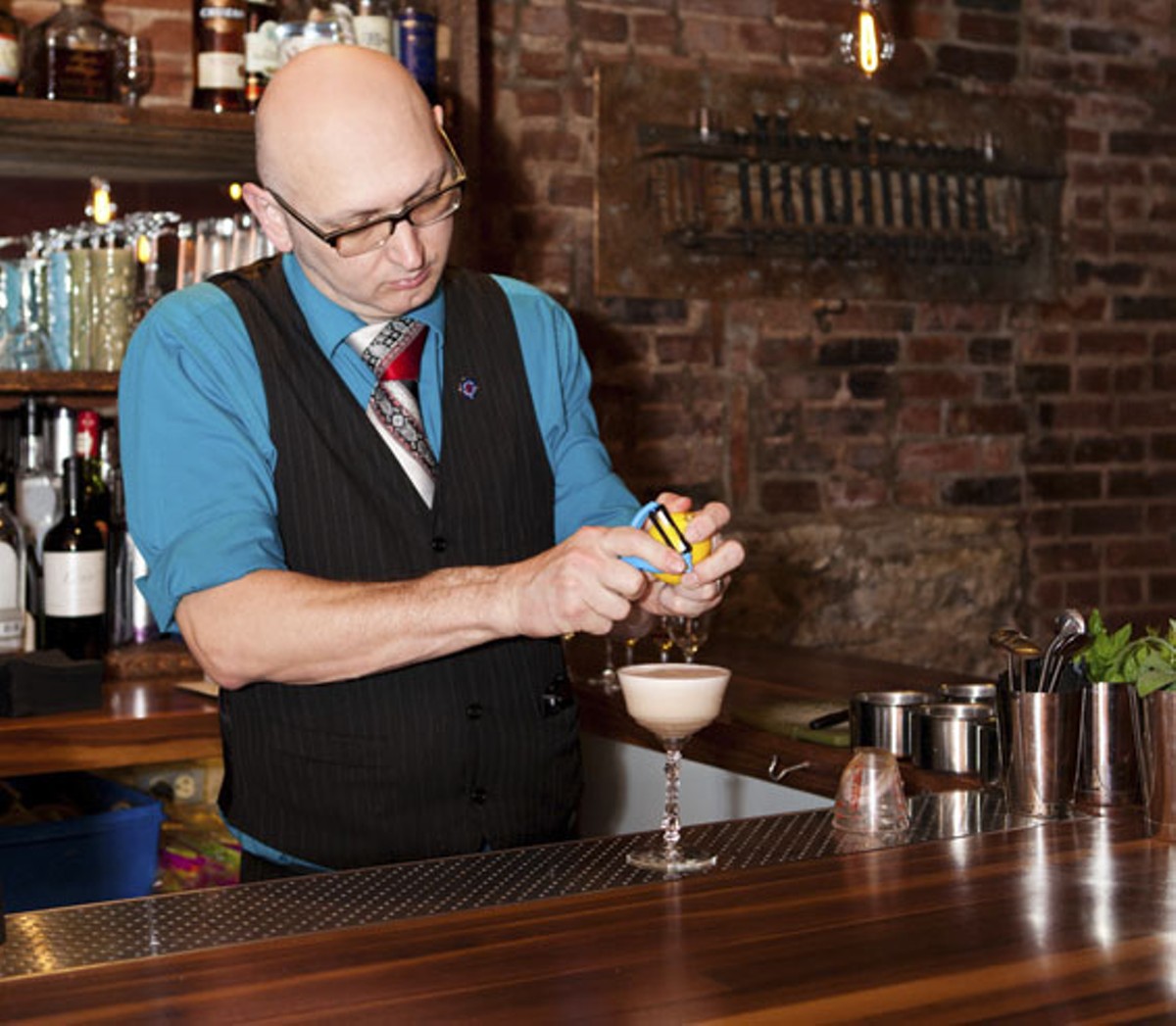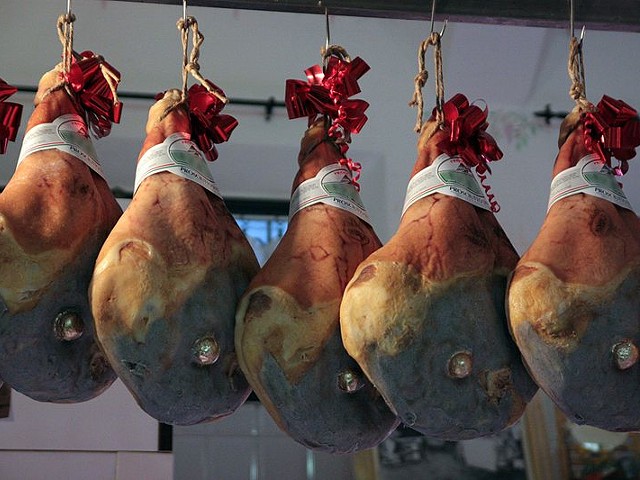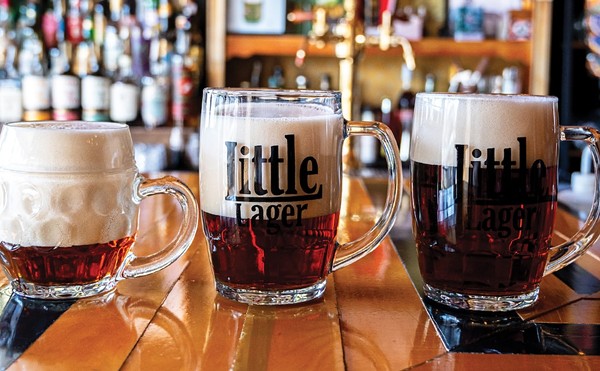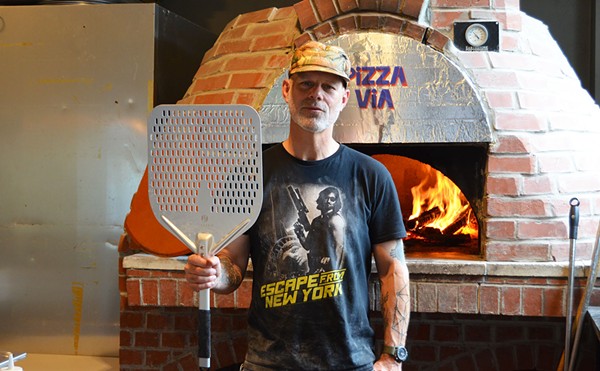The special at Taste this sticky spring evening is simple fare: two slices of toasted bread, each rubbed with garlic and the cut side of a tomato, soaking it in pulp and juice, and then topped with a gossamer slice of house-cured prosciutto. The prosciutto is salty, porky perfection, like silk on the tongue, while the tomato's acidic bite adds a burst of summery brilliance. This is as pure and delicious a thing as you will eat all season.
A simple dish to be sure, but for Adam Altnether, Taste's 24-year-old chef, it marks the culmination of more than a year's work.
"It's kind of like my baby," Altnether says of the prosciutto, which he began curing from the shoulder of a pig of the prized Mangalitsa breed in February of last year. At the time he was chef de cuisine at Niche, and Taste (then known as Taste by Niche) was a cozy spot adjacent to Gerard Craft's acclaimed restaurant. By the end of 2010, Craft had announced first that he intended to move Taste to the address next door to his latest venture, Brasserie by Niche, and then that, while he would remain an investor in Taste, he'd sold the primary interest in the restaurant to Altnether, who in the meantime had left Niche and Benton Park for a spell at Brasserie in the Central West End.
(A couple of months ago, Craft made Altnether a partner in his restaurant group, bringing Taste back under the same ownership umbrella as Niche and Brasserie.)
The early returns on running a restaurant of his own? Altnether laughs. "To say it's been a learning experience would be the biggest understatement. I'm learning every day. I'm the luckiest restaurateur since I have Gerard to coach me through it."
Craft's presence cuts both ways, however. Taste isn't simply a new or relocated restaurant but the reimagining of a concept that won acclaim for being vastly different from every other restaurant in town. Though the original Taste wasn't even a year old when I cobbled together my list of the most important restaurants to open in St. Louis during the Aughts, I ranked it fourth: "At Taste, the barrier between diner and chef is broken down, the intimate confines encouraging a freewheeling conversation with the staff and fellow diners...about how the food is being prepared, what this or that ingredient is, why your cocktail is so good."
At the new Taste, that barrier between diner and chef is back. It is by no means impenetrable, but it is definitely there. Put it this way: At the original Taste, a server didn't have to inform you about a special like the tomato bread with house-cured prosciutto. You could watch as the cooks, working on the other side of the bar where you sat, prepared it; you could hear the little exhalations of pleasure from diners who already were enjoying it.
The new Taste is laid out more or less the same as the restaurant that preceded it at this address, Eric Brenner's Moxy Bistro, was. You enter into the main dining area, a long, narrow space with the bar along one wall and tables along the other. At the far end of this room is an open kitchen just big enough for a couple of cooks to work at once. Stairs lead down to a larger prep kitchen and up to a mezzanine seating area. (There is also a room on the building's second floor for overflow seating and private parties.) Gone, though, is Moxy's slick, nightclub-aping vibe. Taste is all dark wood (including the gorgeous bar) and faint lighting — intimate when you sit across from your beloved, irksome when you attempt to read the menu — from old-school Edison bulbs hung above each table.
The menu has grown both in the number of dishes available and in the scope of those dishes. Although everything is grouped together as "Plates (designed to be shared)," several of the dishes could pass as small or even average-size entrées. Though the fare changes based on seasonal produce and availability, there is less daily variation than there was at the original location.
Explains Altnether: "The cool thing about the older Taste is that we were able to base the menu on things we had in [Niche's] walk-in [refrigerator]. Now, we're actually running a restaurant."
Still, casual is the watchword here — casual and, of course, pork. There are, for example, "pig fries," which look like nothing so much as cheese sticks: pork with a texture rougher than pâté but smoother than sausage that is battered and deep-fried; on the side, for dipping, are a mint sauce and a pungent curry aioli. A pork burger is one of several sandwiches. I opted instead for the mortadella panini, the warm spice and light pistachio notes of the mortadella beautifully complemented by nutty fontina cheese. Also excellent (though of necessity available for only a limited time) is the soft-shell crab sandwich, the crab sensibly paired with nothing more elaborate than lettuce, tomato and — the star of the dish — an aioli flavored with charred green onion.
"Hand Cut Noodles" are a tangle of fresh ribbon pasta in a "sauce" of half-melted Pecorino cheese. Even more than the tomato bread with prosciutto, this is an ode to simplicity: the texture of the pasta, the richness and bite of the cheese, the spicing only the zing of freshly ground black pepper. A tart chock-full of spring vegetables (fava beans, asparagus, carrots and radishes) could have used a tad more spice. Brie gave it some body and character, but the dish as a whole lacked the vibrancy you associate with spring.
Mussels come in a white-wine broth thickened by the mollusks' own liquid and enlivened by red chiles. The broth is outstanding — I'd be content with a bowl of it and some bread — but the kitchen needs to take better care with its mussels. Several in my bowl were gritty, and a couple had opened but a sliver. The misstep stood out especially because it is the kind of detail rarely overlooked in one of the Niche restaurants. Another detail that was in stark contrast to the Niche standard was the table service: It was brusque, at best, and multiple times I had to ask for fresh plates and silverware between courses.
There are a few holdovers from the original menu: the spicy meatballs, the bruschetta with roasted radishes, the carne cruda, the selection of terrines. What hasn't carried over — not yet, anyhow — is the willingness to push St. Louisans' pieholes out of our narrow comfort zone. There is no octopus here, no rabbit and, to use maybe the most famous example from the original Taste, no lamb balls.
Of course, the most important holdover from Taste v1.0 stands behind the bar: Ted Kilgore. The master mixologist, more responsible than anyone else for dragging St. Louis cocktail culture into the here and now, offers a lengthy menu of his creations, handily divided by flavor and body profile (e.g., "crisp, light, aromatic"). To my surprise, given the current heat and humidity, my favorite drinks were listed under the "Full, Dark, Robust" heading: the aptly named "Favorite Things," so named because Kilgore created them using his current favorite libations, mixes Bols Genever gin, the Italian digestif Barolo Chinat, the gentian root- and quinine-flavored aperitif Bonal and the aperitif Antica.
Sitting at the bar, listening to Kilgore describe his drinks, brought back the vibe of the original Taste. (I should mention that while I went unspotted when sitting at a table, Kilgore knows me by sight.) Yes, that restaurant is gone, but if its expanded successor is to flourish, its staff can't lose sight of the passion and attention to detail that Kilgore helped make the hallmark of the original.
Altnether, fresh from pampering his prosciutto from shoulder to sublime, seems like the man to meet the challenge.






